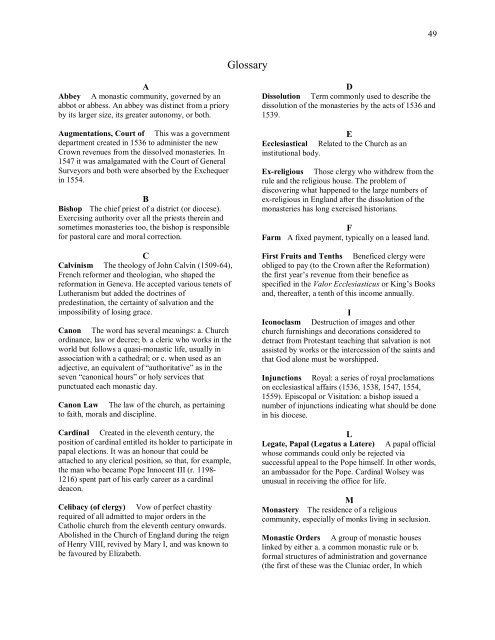The 1536 Dissolution of the Lesser Monasteries: Same Suppression ...
The 1536 Dissolution of the Lesser Monasteries: Same Suppression ...
The 1536 Dissolution of the Lesser Monasteries: Same Suppression ...
Create successful ePaper yourself
Turn your PDF publications into a flip-book with our unique Google optimized e-Paper software.
A<br />
Abbey A monastic community, governed by an<br />
abbot or abbess. An abbey was distinct from a priory<br />
by its larger size, its greater autonomy, or both.<br />
Augmentations, Court <strong>of</strong> This was a government<br />
department created in <strong>1536</strong> to administer <strong>the</strong> new<br />
Crown revenues from <strong>the</strong> dissolved monasteries. In<br />
1547 it was amalgamated with <strong>the</strong> Court <strong>of</strong> General<br />
Surveyors and both were absorbed by <strong>the</strong> Exchequer<br />
in 1554.<br />
B<br />
Bishop <strong>The</strong> chief priest <strong>of</strong> a district (or diocese).<br />
Exercising authority over all <strong>the</strong> priests <strong>the</strong>rein and<br />
sometimes monasteries too, <strong>the</strong> bishop is responsible<br />
for pastoral care and moral correction.<br />
C<br />
Calvinism <strong>The</strong> <strong>the</strong>ology <strong>of</strong> John Calvin (1509-64),<br />
French reformer and <strong>the</strong>ologian, who shaped <strong>the</strong><br />
reformation in Geneva. He accepted various tenets <strong>of</strong><br />
Lu<strong>the</strong>ranism but added <strong>the</strong> doctrines <strong>of</strong><br />
predestination, <strong>the</strong> certainty <strong>of</strong> salvation and <strong>the</strong><br />
impossibility <strong>of</strong> losing grace.<br />
Canon <strong>The</strong> word has several meanings: a. Church<br />
ordinance, law or decree; b. a cleric who works in <strong>the</strong><br />
world but follows a quasi-monastic life, usually in<br />
association with a ca<strong>the</strong>dral; or c. when used as an<br />
adjective, an equivalent <strong>of</strong> ―authoritative‖ as in <strong>the</strong><br />
seven ―canonical hours‖ or holy services that<br />
punctuated each monastic day.<br />
Canon Law <strong>The</strong> law <strong>of</strong> <strong>the</strong> church, as pertaining<br />
to faith, morals and discipline.<br />
Cardinal Created in <strong>the</strong> eleventh century, <strong>the</strong><br />
position <strong>of</strong> cardinal entitled its holder to participate in<br />
papal elections. It was an honour that could be<br />
attached to any clerical position, so that, for example,<br />
<strong>the</strong> man who became Pope Innocent III (r. 1198-<br />
1216) spent part <strong>of</strong> his early career as a cardinal<br />
deacon.<br />
Celibacy (<strong>of</strong> clergy) Vow <strong>of</strong> perfect chastity<br />
required <strong>of</strong> all admitted to major orders in <strong>the</strong><br />
Catholic church from <strong>the</strong> eleventh century onwards.<br />
Abolished in <strong>the</strong> Church <strong>of</strong> England during <strong>the</strong> reign<br />
<strong>of</strong> Henry VIII, revived by Mary I, and was known to<br />
be favoured by Elizabeth.<br />
Glossary<br />
49<br />
D<br />
<strong>Dissolution</strong> Term commonly used to describe <strong>the</strong><br />
dissolution <strong>of</strong> <strong>the</strong> monasteries by <strong>the</strong> acts <strong>of</strong> <strong>1536</strong> and<br />
1539.<br />
E<br />
Ecclesiastical Related to <strong>the</strong> Church as an<br />
institutional body.<br />
Ex-religious Those clergy who withdrew from <strong>the</strong><br />
rule and <strong>the</strong> religious house. <strong>The</strong> problem <strong>of</strong><br />
discovering what happened to <strong>the</strong> large numbers <strong>of</strong><br />
ex-religious in England after <strong>the</strong> dissolution <strong>of</strong> <strong>the</strong><br />
monasteries has long exercised historians.<br />
F<br />
Farm A fixed payment, typically on a leased land.<br />
First Fruits and Tenths Beneficed clergy were<br />
obliged to pay (to <strong>the</strong> Crown after <strong>the</strong> Reformation)<br />
<strong>the</strong> first year‘s revenue from <strong>the</strong>ir benefice as<br />
specified in <strong>the</strong> Valor Ecclesiasticus or King‘s Books<br />
and, <strong>the</strong>reafter, a tenth <strong>of</strong> this income annually.<br />
I<br />
Iconoclasm Destruction <strong>of</strong> images and o<strong>the</strong>r<br />
church furnishings and decorations considered to<br />
detract from Protestant teaching that salvation is not<br />
assisted by works or <strong>the</strong> intercession <strong>of</strong> <strong>the</strong> saints and<br />
that God alone must be worshipped.<br />
Injunctions Royal: a series <strong>of</strong> royal proclamations<br />
on ecclesiastical affairs (<strong>1536</strong>, 1538, 1547, 1554,<br />
1559). Episcopal or Visitation: a bishop issued a<br />
number <strong>of</strong> injunctions indicating what should be done<br />
in his diocese.<br />
L<br />
Legate, Papal (Legatus a Latere) A papal <strong>of</strong>ficial<br />
whose commands could only be rejected via<br />
successful appeal to <strong>the</strong> Pope himself. In o<strong>the</strong>r words,<br />
an ambassador for <strong>the</strong> Pope. Cardinal Wolsey was<br />
unusual in receiving <strong>the</strong> <strong>of</strong>fice for life.<br />
M<br />
Monastery <strong>The</strong> residence <strong>of</strong> a religious<br />
community, especially <strong>of</strong> monks living in seclusion.<br />
Monastic Orders A group <strong>of</strong> monastic houses<br />
linked by ei<strong>the</strong>r a. a common monastic rule or b.<br />
formal structures <strong>of</strong> administration and governance<br />
(<strong>the</strong> first <strong>of</strong> <strong>the</strong>se was <strong>the</strong> Cluniac order, In which
















